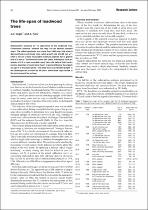JavaScript is disabled for your browser. Some features of this site may not work without it.
- ResearchSpace
- →
- Research Publications/Outputs
- →
- Journal Articles
- →
- View Item
| dc.contributor.author |
Vogel, JC

|
en_US |
| dc.contributor.author |
Fuls, A

|
en_US |
| dc.date.accessioned | 2007-03-16T06:43:33Z | en_US |
| dc.date.accessioned | 2007-06-07T10:05:09Z | |
| dc.date.available | 2007-03-16T06:43:33Z | en_US |
| dc.date.available | 2007-06-07T10:05:09Z | |
| dc.date.copyright | en_US | |
| dc.date.issued | 2005-01 | en_US |
| dc.identifier.citation | Vogel, JC and Fuls, A. 2005. Life-span of leadwood trees. South African Journal of Science, vol 101, January/February, pp 98-100 | en_US |
| dc.identifier.issn | 0038-2353 | en_US |
| dc.identifier.uri | http://hdl.handle.net/10204/1951 | en_US |
| dc.identifier.uri | http://hdl.handle.net/10204/1951 | |
| dc.description.abstract | Radiocarbon analyses on 16 specimens of the Leadwood tree, Combretum imberbe, showed that they live for several hundred years. The oldest specimen was more than 1000 years old when it died and had an extremely slow radial growth rate of 0.33 mm yr(-1), while a tree in a more favourable moisture position had a growth rate of 2 mm yr(-1) and lived for some 300 years. Although a trunk diameter of 2.2 m was recorded, most trees die before their trunks reach a diameter of much more than 1 m and well before they reach an age of a thousand years. The dead trees can remain upright in the landscape for as much as 80 years, while dead logs survive in the environment for as long. In view of the fluctuations in the radiocarbon level, especially over the five centuries prior to AD1950, it is clear that three or more radial samples from the bole are necessary for determining the life span of slow-growing trees. | en_US |
| dc.format.extent | 143979 bytes | en_US |
| dc.format.mimetype | application/pdf | en_US |
| dc.language.iso | en | en_US |
| dc.publisher | South African Journal of Science | en_US |
| dc.rights | Copyright: 2005 South African journal of Science | en_US |
| dc.source | en_US | |
| dc.subject | Leadwood trees | en_US |
| dc.subject | Combretum imberbe | en_US |
| dc.subject | Radiocarbon dating | en_US |
| dc.title | Life-span of leadwood trees | en_US |
| dc.type | Article | en_US |
| dc.identifier.apacitation | Vogel, J., & Fuls, A. (2005). Life-span of leadwood trees. http://hdl.handle.net/10204/1951 | en_ZA |
| dc.identifier.chicagocitation | Vogel, JC, and A Fuls "Life-span of leadwood trees." (2005) http://hdl.handle.net/10204/1951 | en_ZA |
| dc.identifier.vancouvercitation | Vogel J, Fuls A. Life-span of leadwood trees. 2005; http://hdl.handle.net/10204/1951. | en_ZA |
| dc.identifier.ris | TY - Article AU - Vogel, JC AU - Fuls, A AB - Radiocarbon analyses on 16 specimens of the Leadwood tree, Combretum imberbe, showed that they live for several hundred years. The oldest specimen was more than 1000 years old when it died and had an extremely slow radial growth rate of 0.33 mm yr(-1), while a tree in a more favourable moisture position had a growth rate of 2 mm yr(-1) and lived for some 300 years. Although a trunk diameter of 2.2 m was recorded, most trees die before their trunks reach a diameter of much more than 1 m and well before they reach an age of a thousand years. The dead trees can remain upright in the landscape for as much as 80 years, while dead logs survive in the environment for as long. In view of the fluctuations in the radiocarbon level, especially over the five centuries prior to AD1950, it is clear that three or more radial samples from the bole are necessary for determining the life span of slow-growing trees. DA - 2005-01 DB - ResearchSpace DP - CSIR KW - Leadwood trees KW - Combretum imberbe KW - Radiocarbon dating LK - https://researchspace.csir.co.za PY - 2005 SM - 0038-2353 T1 - Life-span of leadwood trees TI - Life-span of leadwood trees UR - http://hdl.handle.net/10204/1951 ER - | en_ZA |






